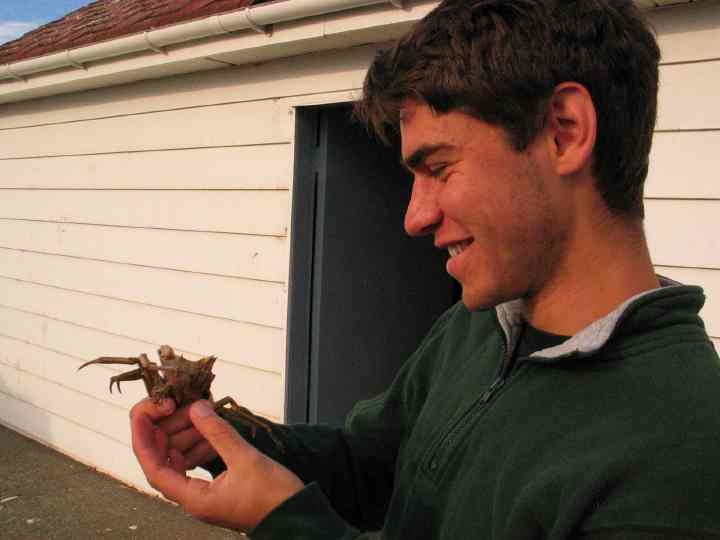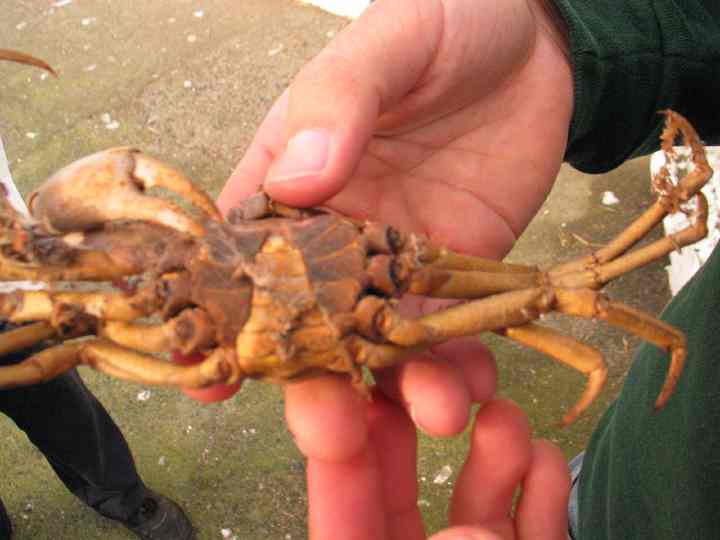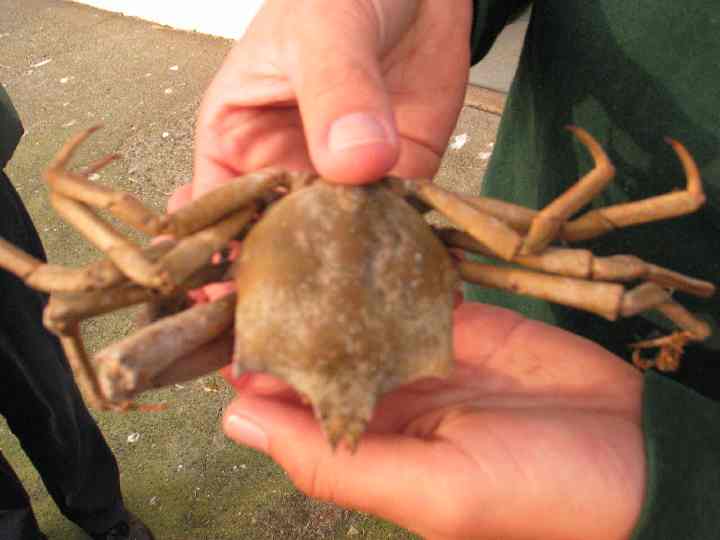A California sea lion decided to haul out this morning on the NE corner of Great Race. Slash has not been sighted yet today on Middle Rock. Bertha and 4252 have not been seen on Great Race for a few days. The seagulls are hatching! Pam B. reports a chick up near the helicopter pad, and a nest beside the winch pad hatched yesterday with two healthy chicks. Pam thinks that the chick near the helicopter pad is several days old. The three black oystercatcher chicks are still being fed down on the rocks beside the jetty. They’ve grown considerably in the last number of days. There are at least two other families on the NE corner of Great Race, as I’ve seen at least two pairs of parents who act quite distressed when I get near.
Dead harbour seal
A dead adult male harbour seal was found washed up today on the rocks beside the derrick. There were no trauma marks from predation or a boat strike and the corpse was still in good condition with no bloating or decomposition. It was removed and taken to Pearson College.
Erik and Al the plumber visited RR today. Ebony departed on the outgoing boat. David H. came later in the afternoon with some guests for a quick tour. There were 5 visitors to the island today. ( Mike Robinson)
Slash still here
Elephant Seal: 2:Slash has been spotted! He is out on Middle Rock, king of the domain out there. Misery is up on Great Race. 4252 and Bertha have not been seen today.
David H. brought out two visitors from the Adriatic College today for a tour. Max and Ebony are also on the Island. There were 5 visitors to the island today.
Pugettia producta: Kelp Crab –The Race Rocks taxonomy
- Hunter holding the Kelp Crab.
- The ventral side. Here you can see the narrow tail segments indicating this is a male
- The Dorsal side
This is a very common crab subtidally at Race Rocks, frequently seen dangling from kelp as it reaches wide with its pincers for catching prey
Domain Eukarya
Kingdom Animalia
Phylum Arthropoda
Class Malacostraca
Order Decapoda
Family Epialtidaae
Genus Pugettia
Species producta
Common Name:Kellp Crab
| Other Members of the Phylum Arthropoda at Race Rocks |
and Image File |
 The Race Rocks taxonomy is a collaborative venture originally started with the Biology and Environmental Systems students of Lester Pearson College UWC. It now also has contributions added by Faculty, Staff, Volunteers and Observers on the remote control webcams. The Race Rocks taxonomy is a collaborative venture originally started with the Biology and Environmental Systems students of Lester Pearson College UWC. It now also has contributions added by Faculty, Staff, Volunteers and Observers on the remote control webcams.
Garry Fletcher |
Gulls territoriality
‘Our three newest black oystercatcher chicks are doing quite well. They ”ve left the nest and are now in the rocky area just beside the jetty. There are several other families on this side of the island, notably one beside the winch house and one in the east bay. There’s also a family or two over in the west surge channel. Most gulls have now settled down into their nests with mating coming to a close. Pam reports a nest up near the fresh water pool is about to hatch; be sure to keep your eye on that one over the next few days! I ”ve noticed on several occasions some broken eggs scattered on the grass around the island. Probable cause: the otter. I saw it scampering across the winch pad the other evening, much to the gulls ” discontentment. There ”s also a dead gull up beside the base of the tower; it ”s been there for a few days now considering the state of decomposition. I expect that it was killed in a territorial fight. Gulls are very territorial birds and will aggressively defend an area of about one metre in radius -with exceptions) around their nest. Any other gull who infringes upon this territory will be the subject of an intense attack – by the owners of that piece of waterfront real estate. Territorial defence is actually one of the reasons why it is important to keep human traffic down in the reserve during gull season: once chicks hatch, any disturbances that cause them to stray from their native territory into another family ”s territory will result in retaliation by the adults of that foreign territory. Chicks are usually helpless to the attacks and will be ruthlessly killed. We have three elephant seals hauled up on Great Race: Misery is up near the engine room, Bertha is behind the tank room and #4252 is on the concrete area at the top of the jetty. 4252 seems to be a bit unwell these days; I ”ve recently observed her breathing heavily and coughing, and her spittle is often flecked with blood. Garry suggests that she could be going through her moult; however, females typically moult in April and May, sub-adult males moult in May and June and adult males moult in July and August. Considering that Misery has now completed his moult and is a breeding male, I ”d expect that 4252, a young female, certainly would have by now. I ”ll be keeping my eye on her over the next bit. There is still an elephant seal out on Middle Rock. Bertha is now most likely approaching the beginning of her seven month gestation period. Female elephant seals come into heat 24 days after giving birth. However, after mating, the fertilized egg does not implant in the wall of the uterus for up to four months, a rare phenomenon called “delayed implantation “. The currently favoured theory is that the female is to weak after giving birth and nursing that she doesn’t have enough energy to nurture the egg. However, once implantation does occur, the actual gestation period is seven months. This gives a total of eleven months and explains the yearly cycle we see. So, if Bertha gave birth and mated in late February, her egg is most likely reaching the implantation stage right now, late June. I expect that in a few weeks gestation will be well underway. I saw a hummingbird pass by my window this morning. I ”m not sure how common they are around here. Unfortunately I couldn’t get a picture as it only briefly flew by. Sea lions are at a seasonal low right now as the California variety move south to breed for the summer while most of the northern variety move northwards for the summer.’, ‘adam’, ’11:28:56 ,
Black Oystercatcher
Our three newest black oystercatcher chicks are doing quite well. They’ve left the nest and are now in the rocky area just beside the jetty. There are several other families on this side of the island, notably one beside the winch house and one in the east bay. There’s also a family or two over in the west surge channel. Most gulls have now settled down into their nests with mating coming to a close. Pam reports a nest up near the fresh water pool is about to hatch; be sure to keep your eye on that one over the next few days! I’ve noticed on several occasions some broken eggs scattered on the grass around the island. Probable cause: the otter. I saw it scampering across the winch pad the other evening, much to the gulls’ discontentment. There’s also a dead gull up beside the base of the tower; it’s been there for a few days now considering the state of decomposition. I expect that it was killed in a territorial fight. Gulls are very territorial birds and will aggressively defend an area of about one metre in radius (with exceptions) around their nest. Any other gull who infringes upon this territory will be the subject of an intense attack (http://www.flickr.com/photos/adamharding/3858558278/in/set-72157622022028013/) by the owners of that piece of waterfront real estate. Territorial defence is actually one of the reasons why it is important to keep human traffic down in the reserve during gull season: once chicks hatch, any disturbances that cause them to stray from their native territory into another family’s territory will result in retaliation by the adults of that foreign territory. Chicks are usually helpless to the attacks and will be ruthlessly killed.
We have three elephant seals hauled up on Great Race: Misery is up near the engine room, Bertha is behind the tank room and #4252 is on the concrete area at the top of the jetty. 4252 seems to be a bit unwell these days; I’ve recently observed her breathing heavily and coughing, and her spittle is often flecked with blood. Garry suggests that she could be going through her moult; however, females typically moult in April and May, sub-adult males moult in May and June and adult males moult in July and August. Considering that Misery has now completed his moult and is a breeding male, I’d expect that 4252, a young female, certainly would have by now. I’ll be keeping my eye on her over the next bit. There is still an elephant seal out on Middle Rock. Bertha is now most likely approaching the beginning of her seven month gestation period. Female elephant seals come into heat 24 days after giving birth. However, after mating, the fertilized egg does not implant in the wall of the uterus for up to four months, a rare phenomenon called “delayed implantation”. The currently favoured theory is that the female is to weak after giving birth and nursing that she doesn’t have enough energy to nurture the egg. However, once implantation does occur, the actual gestation period is seven months. This gives a total of eleven months and explains the yearly cycle we see. So, if Bertha gave birth and mated in late February, her egg is most likely reaching the implantation stage right now, late June. I expect that in a few weeks gestation will be well underway. I saw a hummingbird pass by my window this morning. I’m not sure how common they are around here. Unfortunately I couldn’t get a picture as it only briefly flew by.
Sea lions are at a seasonal low right now as the California variety move south to breed for the summer while most of the northern variety move northwards for the summer.
Orcas again
-113, ‘2010-06-26’, ‘Orca’, 3, ‘Three, I presume transient, orcas swam W -> E through the main passage between Middle Rock and Great Race at 1730, then turned south as they exited the Reserve.’, ‘adam’, ’17:38:53 ,
Glaucous-winged Gull nesting census
230 glaucous-winged gulls were counted on the island today, which puts us at around 115 nests, down from 150 last year at this time.’, ‘adam’, ’12:09:54 ,
maintenance
Human Interaction
Erik, the two winch mechanics and their two guests visited the island today.
There were 5 visitors to the island today.
230 glaucous-winged gulls were counted on the island today, which puts us at around 115 nests, down from 150 last year at this time.
Black Oystercatcher nests
-110, ‘2010-06-21’, ‘Other’, 0, ‘As we officially kick off summer, I thought I ”d give a bit of an update on life on the island right now. The black oystercatcher chicks have hatched in the nest up beside the jetty and down off the tank room! While outside doing some cleanup yesterday morning, I spotted at least one chick, and I suspect there may be more, as there were three eggs in total. This hatching brings some relief, as all of us were quite worried about this nest. Mother oystercatcher had not been spending as much time on her nest as she should have, what with the high traffic transiting the area. However, last week I cordoned off the area with large ropes and she settled down a lot, just in time for the hatching. I also set up camera 3 beside the nest; it can be viewed at http://www.racerocks.com/racerock/video3.htm. I apologize in advance for the moisture on the lens; we ”ve had some high winds and rain over the last day and it has become a bit dirty. At this point though, I ”m a bit apprehensive to get close and clean it, as it ”s really only a foot away from the nest. There are at least two other nests on the island with chicks; one in the surge channel facing the southeast, and one in the channel facing the southwest. In other news, Bertha has decided to make a reappearance on the island after a few days off in the water somewhere. She is hauled up in her favourite spot behind the tank room. Her bad eye is looking worse than ever, and is dripping quite a lot of serum. #4252 is up beside the base of the lighthouse, on the side adjacent to the desalinator bunker, and seems to be enjoying the shelter of the long grasses. Misery is up around the science house somewhere. From the house this morning, I also noticed a possibly fourth, middle-aged, female elephant seal making her way up from the boat ramp -it may have been Bertha though, it ”s hard to tell). Yesterday, three harlequin ducks were spotted in the southeast surge channel, sitting contentedly on rocks. There appeared to be two males and one female. I took some pictures yesterday, but am not sure if they turned out because of the distance. Check on my Flickr site later: http://www.flickr.com/photos/adamharding/. Most seagulls have now settled down into their nests, with a few still mating. Nest numbers seem to be down from this time last year. Enjoy the solstice!’, ‘adam’, ’07:57:59 ,


